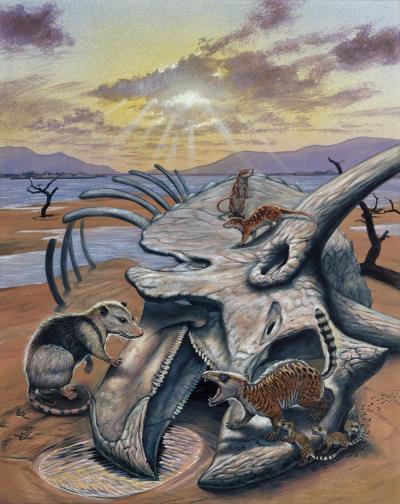Science News
Mind the Gap!
July 13, 2011

Why did dinosaurs go extinct? Did they die all at once or over a long period of time? Scientists have been arguing about possible theories for decades.
The leading theory, put forth by UC Berkeley’s Luis and Walter Alvarez in 1980, is that an asteroid slammed into the earth about 65 million years ago, wiping out the large beasts in a mass extinction event. Iridium became their evidence, according to ScienceNOW:
…they and other researchers found an overabundance of iridium in geological formations at the 65-million-year transition line between the Cretaceous and Tertiary periods, known as the K-T boundary. Iridium is common in asteroids but rare in Earth's crust.
But most dinosaur fossils are found well below the K-T boundary, more than three meters below, in fact. This “three-meter gap” deepened the debate, reports Nature News:
This zone is known for its dearth of dinosaur fossils and has been used in the past to fuel the gradual decline theory.
Gradual decline theories include “climate change, unpredictable sea levels and intense volcanic activity,” according to Wired UK.
A new study, published today in Biology Letters, strongly supports the mass extinction due to asteroid theory. Yale scientists, working in the Hell Creek formation in Montana, discovered the fossilized horn of a ceratopsian—likely a Triceratops, which are common to the area—only 13 centimeters, or 5 inches, from the K-T boundary.
To verify the exact distance, the team sent soil samples to a laboratory to determine the exact location of the boundary, which is marked by the relative abundance of certain types of fossilized pollen and other geological indicators but is difficult to determine visually while in the field.
Because the dinosaur was buried in a mudstone floodplain, the team knew it hadn't been re-deposited from older sediments, which can sometimes happen when fossils are found in riverbeds that may have eroded and re-distributed material over time.
The researchers are now examining other fossil specimens that appear to be buried close to the K-T boundary and expect to find more. They suspect that other fossils discovered in the past may have been closer to the boundary than originally thought and that the so-called three-meter gap never existed.
But this new evidence hardly settles the debate over the death of the dinosaurs. Both ScienceNOW and Nature News quote several scientists who are not quite ready to give up the fight. That’s what makes science fun.
And for more dino science fun, check out this cool Nature News interactive, posted today, on how sauropods grew so large.
Illustration: Mark Hallett